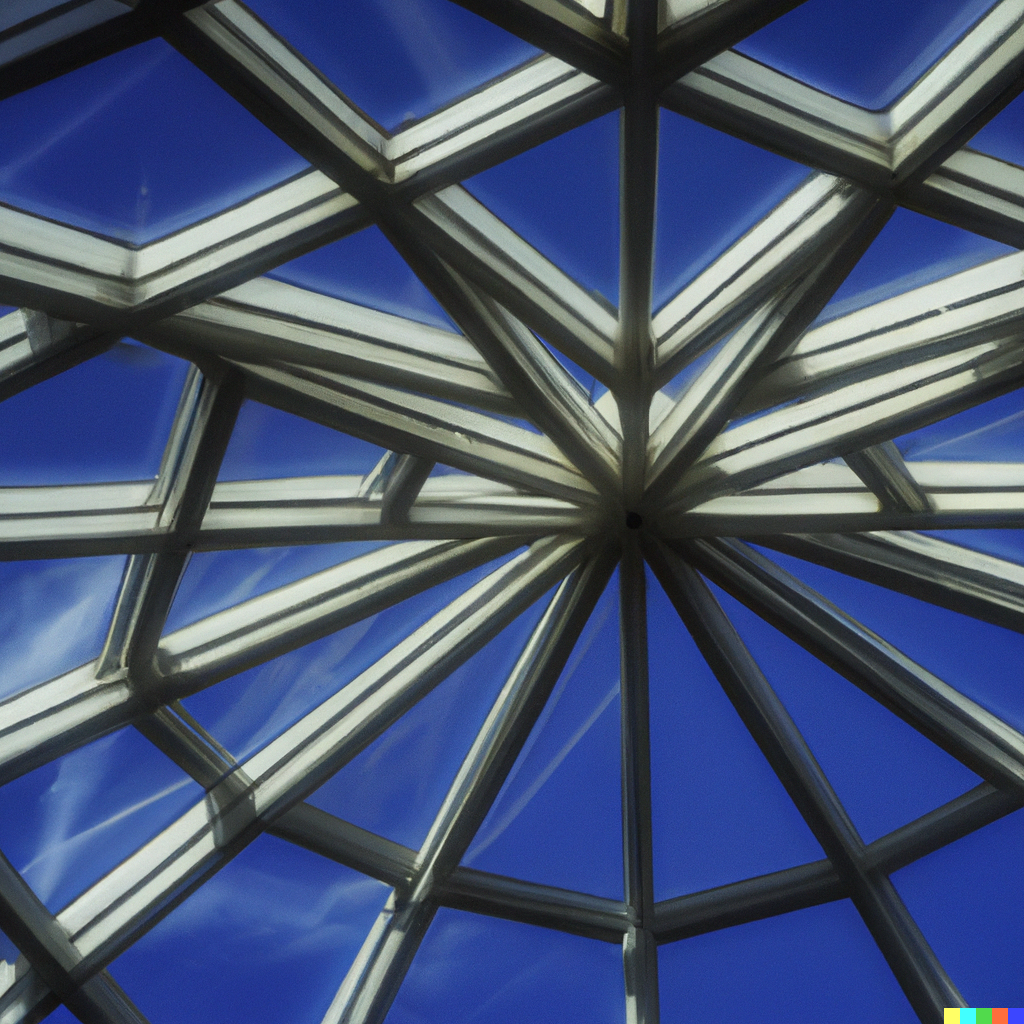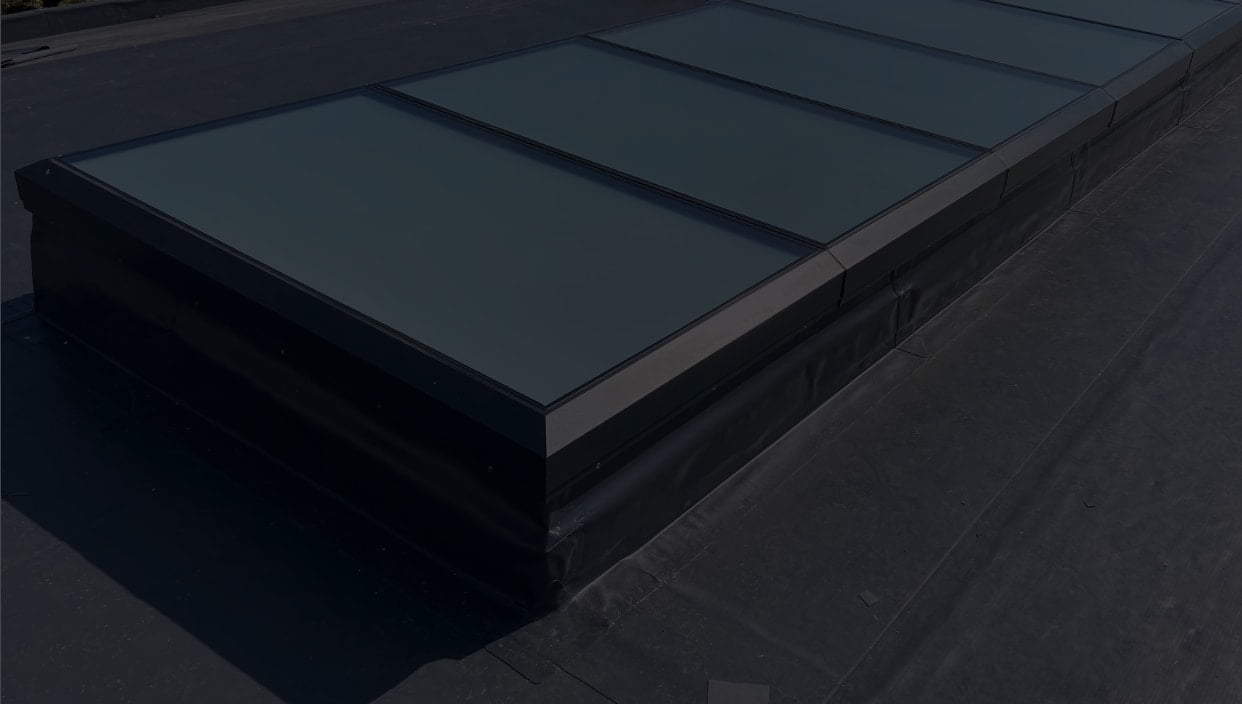
The perfect addition to any room or conservatory, roof lanterns provide the best natural lighting solution for your home or office building.
Before deciding on a new roof lantern it is important to understand exactly what they are, how they differ from roofights, what you can get for your money and more. Whether you need a roof lantern for your attic, extension, conservatory, or even as a vertical installation at the side of your house, these expertly designed lanterns will add extra depth and a stunning conversation piece to your building.
Read our helpful blog to learn all you need to know about roof lanterns.
What is a roof lantern?
A roof lantern is a type of skylight, typically sloped or pyramid-shaped, that is installed onto a flat roof, providing additional natural light to your room. They’re typically made up of four sides that slope upwards towards the centre. This design allows the maximum amount of light to enter the space below, while also providing an attractive focal point for the room. Roof lanterns are usually made of high-quality materials such as aluminium, timber, and uPVC, and come in a range of sizes, finishes, and opening options, to suit different types of properties.
Roof lanterns have become an increasingly popular addition to contemporary home design as practical and stylish architectural features, and are suitable for a range of properties and buildings, including offices and commercial buildings.
What is the difference between a roof lantern and a skylight?
Although rooflights and roof lanterns may seem similar, there are some key differences between the two. A skylight is typically a flat or sloping window that is installed into the roof of a building to allow natural light to enter a room. It is often used in spaces where there is no access to external walls or where a traditional window would not be suitable.
Roof lanterns, however, are raised structures that sit on top of the roof and are designed to allow light to enter a room from above. The sides of a roof lantern slope upwards towards the centre, creating a pyramid-like shape that allows maximum light penetration. While skylights are typically flat and unobtrusive, roof lanterns are more of an architectural feature and can add a significant amount of style and character to a property. You can view our detailed guide on the differences between roof lanterns and flat rooflights.
Interested in a new pyramid roof lantern for your home? The Korniche Pyramid Roof Lantern provides excellent light coverage for your room, with a stylish framed finish and natural self-cleaning options.
What types of roof lantern are there?
There are two main types of roof lantern:
- Contemporary roof lanterns: Sleek designs without intrusive rafters, the minimalist design of contemporary roof lanterns is designed to maximise light
- Traditional roof lanterns: Built with additional rafters as required, traditional roof lanterns are ideal for larger features that require extra structural support
Roof lantern building regulations
In the UK, there are regulations in place for the installation of roof lanterns, primarily due to potential safety hazards that may occur if the proper care is not taken during the installation process. Regulations are in place to ensure that the installation of a roof lantern is safe and complies with the relevant building codes and standards. These cover a range of different aspects of the installation process, including the size of the roof lantern, the materials used, and the structural integrity of the building.
If you are planning to install a roof lantern onto your property, it is important to ensure that you comply with the relevant building regulations. This will involve submitting plans to your local authority and obtaining the necessary permissions before you start work. It is also important to ensure that the installation is carried out by a qualified and experienced professional who understands the regulations and has the necessary skills to carry out the work safely and effectively.
Do you need planning permission to install a roof lantern?
New rooflight installations will not generally require planning permission from a local authority, provided that the roof lantern meets particular energy efficiency and safety standards. These include:
- Any alterations cannot project more than 150mm from the existing roof plane
- Alterations cannot be higher than the highest part of the roof
- Side-facing windows must be obscure-glazed, and if a side-facing window has an opening then it must be 1.7 metres above the floor level.
You should also be aware that you may not be permitted to make changes to certain types of buildings, such as listed buildings or buildings of historic value, but this will require specific research depending on the building you plan to alter. You may be able to have a new conservation rooflight fitted on a building of historic value, but you must consult your local authority before arranging such an installation.
For more information on rooflight planning permission, you can explore our full guide, Building Regulations and Planning Permission for Rooflights: Complete Guide.
Roof lantern benefits
The pyramid design of a roof lantern will benefit the overall natural lighting potential in a room by refracting sunlight and distributing it better across the room. This means that during the day, as the sun moves around your house or building, the angular windows will capture sunlight better and direct it into your room. This is a particularly important design feature if the roof does not benefit from direct sunlight all day.
They can also help you save energy and increase home value.
Potential drawbacks and solutions
Below, we’ve listed a few potential drawbacks to roof lanterns along with some easy solutions:
- Bright rooms: For most people, increased natural light is desirable; however, if you find your room is a bit too bright in summer months, you can easily install roof lantern blinds to solve this.
- Increased temperature: As above, increased room temperature will be a benefit for most, but if you’d like to regulate temperature in your room as it gets warmer outside, blinds will help.
- Noise: It’s possible that outside noise like traffic and rainfall may penetrate the room through your roof lantern. However, if you buy from a company that uses quality glazing, like Toughened Glass Systems, the impact of any exterior noise will be minimal.
- Cleaning: For some, reaching your roof lantern to clean it may be tricky. Self-cleaning glass is a great solution, and is available in several of our products.
How much do roof lanterns cost?
Toughened Glass roof lanterns can be ordered in a range of design specifications, such as different sizes, glazing options, shapes, and glass types. The price of your new roof lantern will change depending on your preferred specifications, for instance, you may wish to order a roof lantern with a higher U value for better thermal efficiency.
You can also order roof lanterns in a variety of sizes to suit any roof space, with larger roof lanterns naturally costing more than smaller ones.
Our roof lanterns can range from £458.33 for a 500mm x 500mm neutral glass Wendland roof lantern, up to £4453.77 for a 6000mm x 2500mm Ambi Aqua model Korniche roof lantern.
How are roof lanterns installed?
Roof lanterns are installed by first having carpenters create an opening, which will take into account the roof lantern size, the size of the upstand the lantern will be fitted onto, and insulation requirements for the sides of the opening to avoid cold bridging and condensation.
Once an opening has been created, the upstand for your roof lantern will usually be installed and a temporary cover may be fitted to protect the inside of your home from rainfall and debris, until the roof lantern is ready for installation. This work will usually be supervised by a building inspector, who will assess the structural integrity of the roof opening and compliance with building regulations.
Builders will then install your new roof lantern on top of the upstand, ensuring that all fittings, sealants, and thermal breaks have been installed correctly and work as intended.
Best position for roof lanterns
When deciding a placement for your roof lantern, you should first consider the position of your house in relation to the sun, and how long direct sunlight will reach the roof area throughout the day. Take into consideration that most roofs will not benefit from direct sunlight all day, so the best position for your roof lantern should be wherever the sun hits your roof for the longest amount of time. You should also think about the time of day you would benefit most from natural light. For instance, if your roof lantern is being installed in a kitchen or dining area so that your family can enjoy breakfast together, you will need to assess which part of the roof gets the most morning sun.
North-facing roof lanterns
North facing rooms will benefit from neutral light throughout the day, rather than direct sunlight. This type of lighting is perfect for artist studios for instance, as neutral light provides a better representation of colour, without being affected by the golden hues of direct sunlight.
East-facing roof lanterns
East-facing rooms will benefit from a tremendous amount of sunlight in the morning, but the amount of light reaching this room will gradually decline throughout the day. A roof lantern placed in an easterly position is best suited if you or your family start your day in the kitchen area.
South-facing roof lanterns
With a south-facing roof lantern, you will benefit from warm light most of the day, with this type of roof lantern being particularly bright in the summer. Any rooms connected to the south facing room will also likely benefit from the light coming through from your roof lantern.
West-facing roof lanterns
West-facing roof space will receive warm light and longer shadows into the late afternoons, creating a relaxing atmosphere with gentle yellow light. Roofs facing west will also benefit from natural light for the longest amount of time.
Roof lanterns are particularly popular on orangeries and conservatories.
How big should my roof lantern be?
A roof lantern should generally cover around 25-30% of the floor area to provide optimal natural lighting to your room. Your new roof lantern can be ordered in a range of sizes, depending on the size of your roof space.
You can view more detailed information on roof lantern sizes in our roof lantern size guide and our helpful blog on measuring for a roof lantern.
Are roof lanterns hard to clean?
Roof lanterns aren’t difficult to clean but, like all glass features, require some maintenance. Our guides below will help you keep your roof lantern looking brand new:
- How to Stop Condensation on Roof Lanterns
- Flies in Your Roof Lantern: Causes and Solutions
- How to Clean Roof Lanterns Inside and Out
We also offer self-cleaning glass on several of our products to make your life easier.
Our products
Toughened Glass Systems provide a range of roof lanterns, skylights, and roof windows for your home. Our high quality selection has helped thousands across the UK transform their homes with bespoke natural lighting solutions.
Explore our full range of roof skylight products, or contact us for more information.
What roof lanterns do we sell?
We sell a range of roof lanterns, including:
We also stock an impressive range of rooflights and skylights, including:







